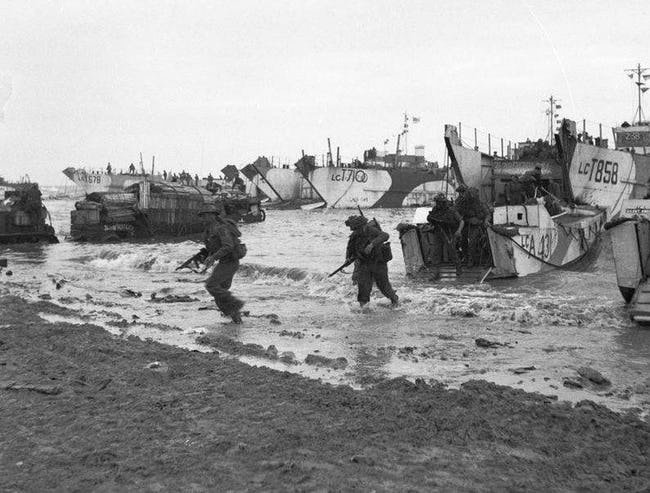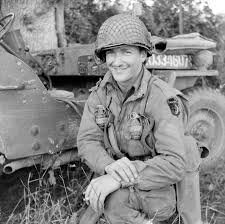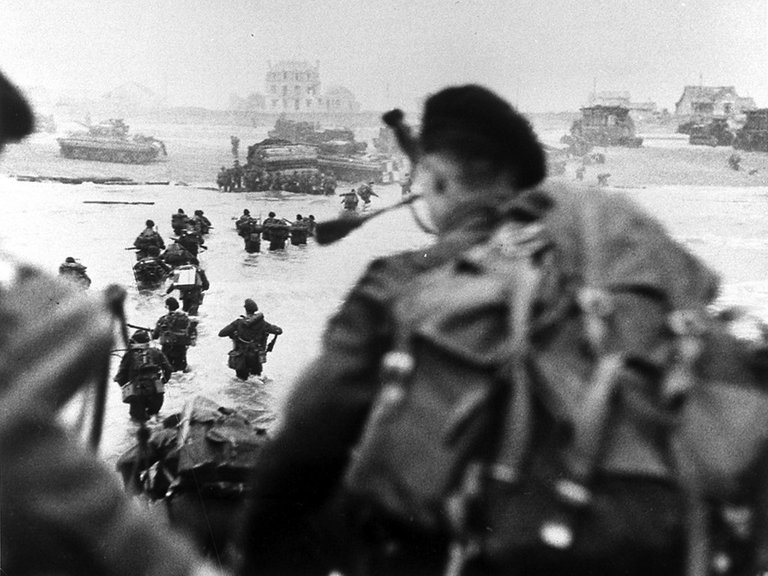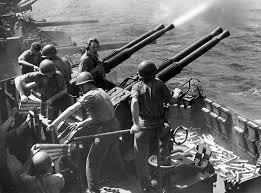 American troops storm the beaches of Normandy, France, on June 6, 1944. D-Day was the largest amphibious invasion in history. More than 160,000 Allied troops -- about half of them Americans -- invaded Western Europe, overwhelming German forces in an operation that proved to be a turning point in World War II.U.S. tro
American troops storm the beaches of Normandy, France, on June 6, 1944. D-Day was the largest amphibious invasion in history. More than 160,000 Allied troops -- about half of them Americans -- invaded Western Europe, overwhelming German forces in an operation that proved to be a turning point in World War II.U.S. tro ops wait to disembark a landing craft on D-Day.American troops help their injured comrades after their landing craft was fired upon. Allied forces secured the beaches at a cost of about 10,000 casualties.French commandos equipped with bicycles disembark from their landing craft after Allied forces stormed the Normandy beaches. Germans rained mortars and artillery down on Allied troops, killing many before they could even get out of their boats. Fighting was especially fierce at Omaha Beach, where Nazi fighters nearlywiped out the first wave of invading forces and left the survivors struggling for cover.The British Army's 50th Infantry Division lands on beaches in Normandy. This photograph is part of an exhibit in London at the Imperial War Museum.An aerial view shows 32 intentionally sunk American merchant ships that served as a breakwater as wellas anti-aircraft platforms.Traffic builds up on the beach and on the road leading to Le Hamel, France, during the landing of the 50th Infantry Division.U.S. troops and vehicles are ready to disembark. D-Day was one of history's most consequential and gut-wrenching battles.A sign outside of Trinity Church in New York invites worshippers to pray for Allied victory in the
ops wait to disembark a landing craft on D-Day.American troops help their injured comrades after their landing craft was fired upon. Allied forces secured the beaches at a cost of about 10,000 casualties.French commandos equipped with bicycles disembark from their landing craft after Allied forces stormed the Normandy beaches. Germans rained mortars and artillery down on Allied troops, killing many before they could even get out of their boats. Fighting was especially fierce at Omaha Beach, where Nazi fighters nearlywiped out the first wave of invading forces and left the survivors struggling for cover.The British Army's 50th Infantry Division lands on beaches in Normandy. This photograph is part of an exhibit in London at the Imperial War Museum.An aerial view shows 32 intentionally sunk American merchant ships that served as a breakwater as wellas anti-aircraft platforms.Traffic builds up on the beach and on the road leading to Le Hamel, France, during the landing of the 50th Infantry Division.U.S. troops and vehicles are ready to disembark. D-Day was one of history's most consequential and gut-wrenching battles.A sign outside of Trinity Church in New York invites worshippers to pray for Allied victory in the D-Day invasion.Commandos with the Royal Navy's 4th Special Service Brigade advance to JunoBeach at Saint-Aubin-sur-mer.Lance Cpl.Walter Ray of the British Army shares a bottle of rum he found floating in the sea.U.S. Gen. Dwight D. Eisenhower, left,supreme commander of the Allied forces, and British Field Marshal BernardMontgomery, right, discuss plans at an undisclosed location in June 1944. The Allies went to elaborate lengths to maintain secrecy and mislead Adolf Hitler. They employed double agents andused decoy tanks and phony bases in England to hide actual troop movements.Eisenhower gives the order of the day to paratroopers in England."Full victory -- nothing else" was the command just before they boarded their planes to participate in the first wave. The invasion -- code-named Operation Overlord -- had been brewing for more than two years.British troops pose for a photograph with a French woman in La Breche d'Hermanville.U.S. troops huddlebehind the protective front of their landing craft as it nears a beachhead. Smoke in the background is naval gunfire, giving cover to troops on land.(CNN)
D-Day invasion.Commandos with the Royal Navy's 4th Special Service Brigade advance to JunoBeach at Saint-Aubin-sur-mer.Lance Cpl.Walter Ray of the British Army shares a bottle of rum he found floating in the sea.U.S. Gen. Dwight D. Eisenhower, left,supreme commander of the Allied forces, and British Field Marshal BernardMontgomery, right, discuss plans at an undisclosed location in June 1944. The Allies went to elaborate lengths to maintain secrecy and mislead Adolf Hitler. They employed double agents andused decoy tanks and phony bases in England to hide actual troop movements.Eisenhower gives the order of the day to paratroopers in England."Full victory -- nothing else" was the command just before they boarded their planes to participate in the first wave. The invasion -- code-named Operation Overlord -- had been brewing for more than two years.British troops pose for a photograph with a French woman in La Breche d'Hermanville.U.S. troops huddlebehind the protective front of their landing craft as it nears a beachhead. Smoke in the background is naval gunfire, giving cover to troops on land.(CNN) Here is a look at D-Day. Allied troops invaded Normandy, France, on June 6, 1944, to fight Nazi Germany in World War II.Facts:The largest amphibious (land and water) invasion in history.The code name for the invasion was Operation Overlord.General Dwight D. Eisenhower commanded the operation, and plans were made to land in Normandy, west of where the German troops and artillery were built up.More: See historic photos from the landing.The "D" stands for Day. D-Day is code forthe day an important military attack is scheduled to begin.Code names for the five beaches where the Allies landed: Utah, Omaha, Gold, Juno, and Sword.More than 13,000 aircraft and 5,000 ships supported the operation.Although the true number of casualties on June 6, 1944, will never be known, it isestimated that approximately 10,000 Allied soldiers were killed, wounded and or were missing in action: 6,603 Americans, 2,700 British, and 946 Canadians.Timeline:August 19, 1942 -A raid on the French port of Dieppe resulting in heavy losses convinces D-Day planners to land on the beaches, so discussions and preparations begin for an Allied invasion across the English Channel.May 1943 -The Trident Conference, a British and American strategy meeting on the war. In Washington, DC, Winston Churchill, President Roosevelt and their military advisers discuss, among other things, crossing the English Channel.August 1943 -The Quadrant Conference,where the British and American military chiefs of staff outline Operation
Here is a look at D-Day. Allied troops invaded Normandy, France, on June 6, 1944, to fight Nazi Germany in World War II.Facts:The largest amphibious (land and water) invasion in history.The code name for the invasion was Operation Overlord.General Dwight D. Eisenhower commanded the operation, and plans were made to land in Normandy, west of where the German troops and artillery were built up.More: See historic photos from the landing.The "D" stands for Day. D-Day is code forthe day an important military attack is scheduled to begin.Code names for the five beaches where the Allies landed: Utah, Omaha, Gold, Juno, and Sword.More than 13,000 aircraft and 5,000 ships supported the operation.Although the true number of casualties on June 6, 1944, will never be known, it isestimated that approximately 10,000 Allied soldiers were killed, wounded and or were missing in action: 6,603 Americans, 2,700 British, and 946 Canadians.Timeline:August 19, 1942 -A raid on the French port of Dieppe resulting in heavy losses convinces D-Day planners to land on the beaches, so discussions and preparations begin for an Allied invasion across the English Channel.May 1943 -The Trident Conference, a British and American strategy meeting on the war. In Washington, DC, Winston Churchill, President Roosevelt and their military advisers discuss, among other things, crossing the English Channel.August 1943 -The Quadrant Conference,where the British and American military chiefs of staff outline Operation  Overlord.November and December 1943 -The Sextant and Eureka Conferences, where the British and American military chiefs discuss the specifics of the assault on France.1944 -The Germans expect an invasion along the north coast of France, but they do not know where. They build up their troops and artillery near Calais, where the English Channel is the narrowest.June 5, 1944 -Allied paratroopers and gliders carrying heavy equipment leave England to begin the invasion of France by air.In a broadcast message to troops beforethey leave, Eisenhower tells them, "The tide has turned! The free men of the world are marching together to victory....We will accept nothing less than full victory!"June 6, 1944 -Overnight, a military armada and more than 160,000 troops cross the English Channel. Minesweepers go ahead to clear the waters in preparation for the thousands of landing crafts that will be carrying men, vehicles and
Overlord.November and December 1943 -The Sextant and Eureka Conferences, where the British and American military chiefs discuss the specifics of the assault on France.1944 -The Germans expect an invasion along the north coast of France, but they do not know where. They build up their troops and artillery near Calais, where the English Channel is the narrowest.June 5, 1944 -Allied paratroopers and gliders carrying heavy equipment leave England to begin the invasion of France by air.In a broadcast message to troops beforethey leave, Eisenhower tells them, "The tide has turned! The free men of the world are marching together to victory....We will accept nothing less than full victory!"June 6, 1944 -Overnight, a military armada and more than 160,000 troops cross the English Channel. Minesweepers go ahead to clear the waters in preparation for the thousands of landing crafts that will be carrying men, vehicles and  supplies.Between midnight and 8 a.m., Allied forces fly 14,674 sorties.6:30 a.m. -Troops begin coming ashore on a 50-mile front.More: Before and after D-Day: Color photosIn a broadcast to the people of occupiedEurope, Eisenhower says, "Although the initial assault may not have been made in your own country, the hour of your liberation is approaching."More about World War II andveterans:By the numbers: Veterans from US warsCNN Heroes: Making life easier for disabled veteransDaughter faces demons of father's warWWII Marine's diary found by sweetheartyears laterMust-see sights for military b
supplies.Between midnight and 8 a.m., Allied forces fly 14,674 sorties.6:30 a.m. -Troops begin coming ashore on a 50-mile front.More: Before and after D-Day: Color photosIn a broadcast to the people of occupiedEurope, Eisenhower says, "Although the initial assault may not have been made in your own country, the hour of your liberation is approaching."More about World War II andveterans:By the numbers: Veterans from US warsCNN Heroes: Making life easier for disabled veteransDaughter faces demons of father's warWWII Marine's diary found by sweetheartyears laterMust-see sights for military b
Hi! I am a robot. I just upvoted you! I found similar content that readers might be interested in:
https://www.cnn.com/2013/06/03/world/europe/d-day-fast-facts/index.html